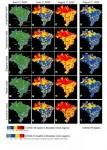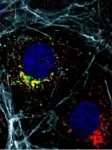INFORMATION:
The authors of this paper were: Miguel A.L. Nicolelis, Department of Neurobiology, Duke University Medical Center, Durham, NC, USA, and Edmond and Lily Safra International Institute of Neurosciences, Natal, Brazil, Rafael L. G. Raimundo, Department of Engineering and Environment and Postgraduate Program in Ecology and Environmental Monitoring (PPGEMA), Center for Applied Science and Education, Universidade Federal da Paraíba - Campus IV, Rio Tinto, Paraíba, Brazil, Pedro S. Peixoto, Department of Applied Mathematics, Institute of Mathematics and Statistics, University of São Paulo, São Paulo, Brazil, and Cecilia S. Andreazzi, Laboratory of Biology and Parasitology of Wild Reservoir Mammals, IOC, Oswaldo Cruz Foundation, Rio de Janeiro, Brazil. Mobility data utilized in this study was obtained from a collaboration between the Department of Applied Mathematics, Institute of Mathematics and Statistics, University of São Paulo, and the company InLoco/Incognia.
Article link:
https://doi.org/10.1038/s41598-021-92263-3
The paths through which COVID-19 spread across Brazil
The impact of super-spreader cities, highways, and intensive care availability in the early stages of the COVID-19 epidemic in Brazil
2021-06-21
(Press-News.org) São Paulo, Brazil - A multidisciplinary analysis by a group of Brazilian scientists, published online in the journal Scientific Reports on June 21, 2021, revealed that three major factors accounted for the geographic spread of SARS-COV-2 across Brazil, as well as the massive flow of people in search of hospital care throughout the country, during the first wave of the pandemic in 2020. SARS-CoV-2 entered Brazil at the end of February 2020 through the country's international airports. Mathematical modeling revealed that during the first weeks of March 2020, the "super-spreader city" of São Paulo, located next to both the largest Brazilian international airport and the busiest highway hub in the country, accounted for more than 85% of COVID-19's case spread throughout Brazil. By considering only 16 other spreader cities, the authors were able to account for 98-99% of the cases reported during the first 3 months of the Brazilian pandemic in 2020. Most of this spread of COVID-19 cases resulted from people traveling across the country's major highways and its air space, which remained open during the entire month of March 2020. For instance, a group of 26 major federal highways alone accounted for about 30% of SARS-CoV-2's case spread during this period.
Following the emergence of community transmission in the major 16 super-spreader, SARS-CoV-2 cases spread to the Brazilian countryside through the country's federal and state highways. As cases increased exponentially in the Brazilian interior, severely ill patients from the country's interior had to be transported to state capitals to access ICU beds, creating a "boomerang effect" that contributed to skewing the distribution of COVID-19 deaths. Therefore, the distribution of COVID-19 deaths began to correlate with the allocation of the country's highly uneven distribution of intensive care units (ICUs), which is heavily weighted towards state capitals.
According to Miguel Nicolelis, one of the authors of the study "our analysis clearly showed that if a national lockdown and mandatory road traffic restrictions had been enforced around the main Brazilian super-spreader cities, particularly in the city of São Paulo, the impact of COVID-19 in Brazil would be significantly lower during the first wave, but also during the even more damaging second wave that hit the country a year later in the summer of 2021. From June 2020 to June 2021 Brazil went from 50,000 to 500,000 deaths, a tenfold increase in 12 months. This alone illustrates the utter failure of the Brazilian federal government to protect Brazilians from the worst humanitarian tragedy in the country's entire history."
In Brazil, the vast majority of tertiary hospitals, and hence the largest share of critical care beds, are located in large cities that serve as state capitals, their metropolitan areas, and a handful of mid-sized towns in each state's interior. As a result of the highly pervasive "boomerang effect" throughout the country, Brazil experienced the largest hospital admission surge in its history, leading to fatality peaks in each of the cities with a large number of critical care units. Such a "boomerang flow" was not restricted to roads and highways. For instance, in the Amazon rain forest, located in the north region of Brazilian, severely ill COVID-19 patients from many small riverside communities were transported by boats of all sorts via its large rivers towards the two largest Amazon cities, Manaus and Belém. Overall, analysis of the geographic flow of COVID-19 patients revealed that São Paulo, the largest Brazilian super-spreader city, received patients from 464 different cities all over Brazil, followed by Belo Horizonte (351 cities), Salvador (332 cities), Goiânia (258 cities), Recife (255 cities), and Teresina (225 cities). São Paulo was also the city that sent more residents to be hospitalized in other cities (158 cities), followed by Rio de Janeiro (73 cities), Guarulhos (41 cities), Curitiba (40 cities), Campinas (39 cities), Belém (38 cities), and Brasília (35 cities). Overall, cities that were highly connected to the health system network, either by receiving from or sending patients to other cities, also experienced a higher number of COVID-19 deaths. Therefore, as a result of the "boomerang effect", a significant number of severely ill patients had to migrate to larger cities for treatment and, eventually, a significant number of them perished there. Combined with the deaths of the residents of large cities, the widespread "boomerang effect" contributed decisively to the geographic skewing of the COVID-19 death distribution in all of Brazil.
Commenting on the study's findings, Rafael Raimundo, another author, said that "our analysis elucidated in great detail the mechanisms through which COVID-19 quickly spread throughout Brazil. Our findings also indicate that if non-pharmacological measures, such as highways blocks and lockdowns, had been enforced early on at a national or even regional level thousands of lives could have been saved at the onset of the COVID-19 pandemic in Brazil".
The authors also emphasized in their conclusions the fundamental importance of the Brazilian Public Health System, known as SUS. According to Rafael Raimundo "without the public health infrastructure of SUS, built during the past 40 years, the impact of COVID-19 would certainly be even more devastating. Yet, our data also show that the high magnitude of the "boomerang effect" highlights the need for SUS to install more hospital infrastructure, including more critical care unit beds, in the Brazilian interior to better assist and serve the population in the countryside."
"Certainly, the widespread absence of adequate hospital infrastructure and health professionals in the Brazilian countryside contributed decisively to a high number of deaths that could have been avoided altogether. Yet, if the Brazilian federal government had reacted quickly and properly to the arrival of SARS-CoV-2, by creating a national scientific task force in charge of fighting the pandemic, while implementing a national communication campaign to alert the population, and had closed the country's air space, while implementing a national lockdown in early March 2020, including establishing roadblocks on the major federal and state highways, Brazil would almost certainly have avoided the loss of tens of thousands of lives," added Miguel Nicolelis.
ELSE PRESS RELEASES FROM THIS DATE:
Risk of forced labour in clothing industry rises due to pandemic and industry response
2021-06-21
First and only report to interview large sample of workers in garment supply chain (1200 workers across 302 factories and four countries) found an increase in risk of forced labour during pandemic
This risk has been exacerbated by the response of retail companies, and there is little evidence most have acted in line with their social responsibilities to support their supply chain workers, despite many accessing pandemic recovery funds
A new comprehensive system was used during the study to look for the indicators that someone is vulnerable to forced labour
The recovery from the pandemic should include support for supply chain workers to mitigate the deterioration ...
Indigenous people travel long distances to give birth compared with non-Indigenous people
2021-06-21
Indigenous people living in rural Canada are 16 times more likely to have to travel 200 km or more to give birth than non-Indigenous people, underscoring the need for more access to birthing facilities and providers for Indigenous families in rural regions, found new research published in CMAJ (Canadian Medical Association Journal) https://www.cmaj.ca/lookup/doi/10.1503/cmaj.201903.
Using data from the Canadian Maternity Experiences Survey (MES), this study included 3100 mothers living in rural and small towns in Canada and weighted the sample to represent 31,100 mothers, totaling 1800 Indigenous and 29,300 non-Indigenous mothers. First Nations women living on-reserve were excluded from the MES. Indigenous ...
COVID-19-related multisystem inflammatory syndrome in adults: rare but possible
2021-06-21
In rare cases, adults who have recovered from COVID-19 may develop multisystem inflammatory syndrome, and clinicians should consider this possibility in adults with specific symptoms, as physicians describe in a case published in CMAJ (Canadian Medical Association Journal) https://www.cmaj.ca/lookup/doi/10.1503/cmaj.210232.
A 60-year-old man, who had tested positive for SARS-CoV-2 four weeks before, visited hospital for a range of symptoms, including prolonged shortness of breath, high fever, swelling and severe fatigue. Testing found an enlarged heart and lung swelling as well as other issues.
"Given the patient's recent history of SARS-CoV-2 infection, fevers without localizing ...
Study reveals racial and ethnic disparities in childhood cancers by single year of age
2021-06-21
New research uncovers substantial differences in rates of childhood cancers when considering single year of age rather than grouping several years together. The study published by Wiley early online in CANCER, a peer-reviewed journal of the American Cancer Society, also found that minority children have different risks than white children for many types of cancer.
Cancer rates among children in the United States are typically reported in 5-year age groups, which may obscure important details. Also, racial and ethnic variations in pediatric cancer rates are typically presented in ...
Smaller bodies, longer wings, earlier migrations: Untangling the multiple impacts of climate warming
2021-06-21
When a University of Michigan-led research team reported last year that North American migratory birds have been getting smaller over the past four decades and that their wings have gotten a bit longer, the scientists wondered if they were seeing the fingerprint of earlier spring migrations.
Multiple studies have demonstrated that birds are migrating earlier in the spring as the world warms. Perhaps the evolutionary pressure to migrate faster and arrive at breeding grounds earlier led to the physical changes the U-M-led team observed.
"We know that bird morphology has a major effect on the efficiency and speed of flight, so we became curious whether the environmental ...
Genetic cause of neurodevelopmental disorder discovered
2021-06-21
University of Maryland School of Medicine (UMSOM) researchers identified a new gene that may be linked to certain neurodevelopmental disorders and intellectual disabilities. The researchers believe that finding genes involved in certain types of developmental disorders, provide an important first step in determining the cause of these disorders and ultimately in developing potential therapies for treating them. The paper was recently published in the American Journal of Human Genetics.
About 3 percent of the world's population has intellectual disability. Up to half the cases are due to genetics, however, because many thousands of genes contribute to brain development, it has been difficult to identify the specific cause for each patient.
Once the researchers ...
Research suggests mask-wearing can increase struggles with social anxiety
2021-06-21
People who struggle with social anxiety might experience increased distress related to mask-wearing during and even after the COVID-19 pandemic.
A paper authored by researchers from the University of Waterloo's Department of Psychology and Centre for Mental Health Research and Treatment also has implications for those who haven't necessarily suffered from social anxiety in the past.
"The adverse effects of the COVID-19 pandemic on mental health outcomes, including anxiety and depression, have been well-documented," said David Moscovitch, professor of clinical psychology and co-author of the paper. "However, little is known about effects of increased mask-wearing on social interactions, social anxiety, or overall mental health.
"It is also possible ...
Pathogenic bacteria rendered almost harmless
2021-06-21
Pseudomonas aeruginosa is an opportunistic pathogenic bacterium present in many ecological niches, such as plant roots, stagnant water or even the pipes of our homes. Naturally very versatile, it can cause acute and chronic infections that are potentially fatal for people with weakened immune systems. The presence of P. aeruginosa in clinical settings, where it can colonise respirators and catheters, is a serious threat. In addition, its adaptability and resistance to many antibiotics make infections by P. aeruginosa increasingly difficult to treat. There is therefore an urgent need to develop new antibacterials. Scientists from the University of Geneva (UNIGE), Switzerland, ...
COVID-19 leads to cognitive and behavioural problems in patients, new study reveals
2021-06-21
(Vienna, Monday, 21 June, 2021) COVID-19 patients suffer from cognitive and behavioural problems two months after being discharged from hospital, a new study presented at the 7th Congress of the European Academy of Neurology (EAN) has found.
Issues with memory, spatial awareness and information processing problems were identified as possible overhangs from the virus in post-COVID-19 patients who were followed up within eight weeks.
The research also found that one in 5 patients reported post-traumatic stress disorder (PTSD), with 16% presenting depressive symptoms. ...
Global standards to embed health and wellbeing into education system
2021-06-20
The first global standards to embed health and wellbeing into the education system have been created amid a rise in mental health problems during the COVID-19 pandemic.
Researchers at the Centre for Adolescent Health at the Murdoch Children's Research Institute (MCRI) led the two-year project at the invitation of the World Health Organization (WHO) and the United Nations Educational, Scientific and Cultural Organization (UNESCO). The two reports, to be launched this week in Geneva, provide a benchmarking framework to support the implementation of 'health promoting schools,' which aim to equally foster health ...
LAST 30 PRESS RELEASES:
Numbers in our sights affect how we perceive space
SIMJ announces global collaborative book project in commemoration of its 75th anniversary
Air pollution exposure and birth weight
Obstructive sleep apnea risk and mental health conditions among older adults
How talking slows eye movements behind the wheel
The Ceramic Society of Japan’s Oxoate Ceramics Research Association launches new international book project
Heart-brain connection: international study reveals the role of the vagus nerve in keeping the heart young
Researchers identify Rb1 as a predictive biomarker for a new therapeutic strategy in some breast cancers
Survey reveals ethical gaps slowing AI adoption in pediatric surgery
Stimulant ADHD medications work differently than thought
AI overestimates how smart people are, according to HSE economists
HSE researchers create genome-wide map of quadruplexes
Scientists boost cell "powerhouses" to burn more calories
Automatic label checking: The missing step in making reliable medical AI
Low daily alcohol intake linked to 50% heightened mouth cancer risk in India
American Meteorological Society announces Rick Spinrad as 2026 President-Elect
Biomass-based carbon capture spotlighted in newly released global climate webinar recording
Illuminating invisible nano pollutants: advanced bioimaging tracks the full journey of emerging nanoscale contaminants in living systems
How does age affect recovery from spinal cord injury?
Novel AI tool offers prognosis for patients with head and neck cancer
Fathers’ microplastic exposure tied to their children’s metabolic problems
Research validates laboratory model for studying high-grade serous ovarian cancer
SIR 2026 delivers transformative breakthroughs in minimally invasive medicine to improve patient care
Stem Cell Reports most downloaded papers of 2025 highlight the breadth and impact of stem cell research
Oxford-led study estimates NHS spends around 3% of its primary and secondary care budget on the health impacts of heat and cold in England
A researcher’s long quest leads to a smart composite breakthrough
Urban wild bees act as “microbial sensors” of city health.
New study finds where you live affects recovery after a hip fracture
Forecasting the impact of fully automated vehicle adoption on US road traffic injuries
Alcohol-related hospitalizations from 2016 to 2022
[Press-News.org] The paths through which COVID-19 spread across BrazilThe impact of super-spreader cities, highways, and intensive care availability in the early stages of the COVID-19 epidemic in Brazil



